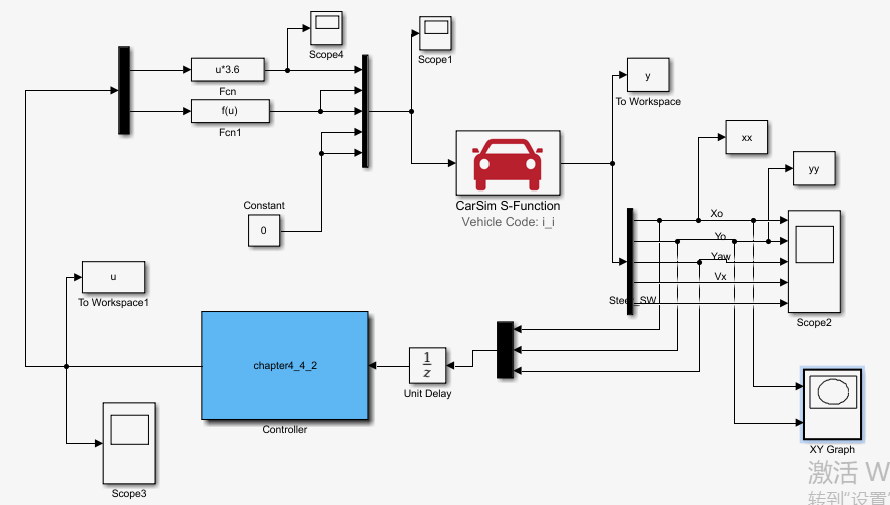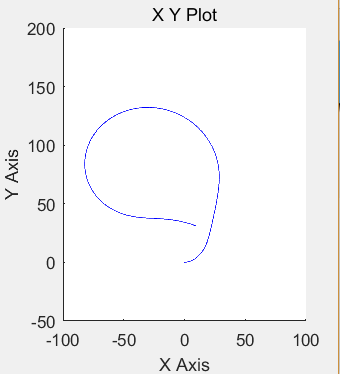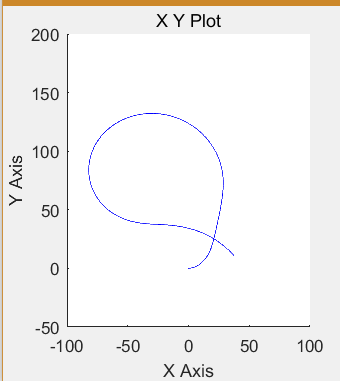无人驾驶模型预测控制第二版(第四章仿真)
本文总字数:7289,阅读预计需要:18分钟
simulink中的模型(s-function中的程序放在最后,以免影响阅读)

仿真时间设置成20,仿真结果图像 { 跟踪轨迹是半径25m的圆形轨迹,圆心为(0,35))}

仿真时间设置成30时

图像中的轨迹在仿真时间20之后不再跟随轨迹,目前还没找到原因
s-function中的程序代码
function [sys,x0,str,ts] = MY_MPCController3(t,x,u,flag)
% 该函数是写的第3个S函数控制器(MATLAB版本:R2011a)
% 限定于车辆运动学模型,控制量为速度和前轮偏角,使用的QP为新版本的QP解法
% [sys,x0,str,ts] = MY_MPCController3(t,x,u,flag)
%
% is an S-function implementing the MPC controller intended for use
% with Simulink. The argument md, which is the only user supplied
% argument, contains the data structures needed by the controller. The
% input to the S-function block is a vector signal consisting of the
% measured outputs and the reference values for the controlled
% outputs. The output of the S-function block is a vector signal
% consisting of the control variables and the estimated state vector,
% potentially including estimated disturbance states.
switch flag,
case 0
[sys,x0,str,ts] = mdlInitializeSizes; % Initialization
case 2
sys = mdlUpdates(t,x,u); % Update discrete states
case 3
sys = mdlOutputs(t,x,u); % Calculate outputs
case {1,4,9} % Unused flags
sys = [];
otherwise
error(['unhandled flag = ',num2str(flag)]); % Error handling
end
% End of dsfunc.
%==============================================================
% Initialization
%==============================================================
function [sys,x0,str,ts] = mdlInitializeSizes
% Call simsizes for a sizes structure, fill it in, and convert it
% to a sizes array.
sizes = simsizes;
sizes.NumContStates = 0;
sizes.NumDiscStates = 3; % this parameter doesn't matter
sizes.NumOutputs = 2; %[speed, steering]
sizes.NumInputs = 3; % =======
sizes.DirFeedthrough = 1; % Matrix D is non-empty.
sizes.NumSampleTimes = 1;
sys = simsizes(sizes);
x0 =[0;0;0];
global U; % store current ctrl vector:[vel_m, delta_m]
U=[0;0];
% Initialize the discrete states.
str = []; % Set str to an empty matrix.
ts = [0.1 0]; % sample time: [period, offset]
%End of mdlInitializeSizes
%==============================================================
% Update the discrete states
%==============================================================
function sys = mdlUpdates(t,x,u)
sys = x;
%End of mdlUpdate.
%==============================================================
% Calculate outputs
%==============================================================
function sys = mdlOutputs(t,x,u)
global a b u_piao;
global U; %store chi_tilde=[vel-vel_ref; delta - delta_ref]
global kesi;
tic
Nx=3;%状态量的个数
Nu =2;%控制量的个数
Np =60;%预测步长
Nc=30;%控制步长
Row=10;%松弛因子
%fprintf('Update start, t=%6.3f\n',t)
t_d =u(3)*3.1415926/180;%CarSim输出的Yaw angle为角度,角度转换为弧度
% 直线路径
% r(1)=5*t; %ref_x-axis
% r(2)=5;%ref_y-axis
% r(3)=0;%ref_heading_angle
% vd1=5;% ref_velocity
%vd2=0;% ref_steering
% 半径为25m的圆形轨迹, 圆心为(0, 35), 速度为5m/s
r(1)=25*sin(0.2*t);
r(2)=25+10-25*cos(0.2*t);
r(3)=0.2*t;
vd1=5;
vd2=0.104;
% %半径为35m的圆形轨迹, 圆心为(0, 35), 速度为3m/s
% r(1)=25*sin(0.12*t);
% r(2)=25+10-25*cos(0.12*t);
% r(3)=0.12*t;
% vd1=3;
% vd2=0.104;
% 半径为25m的圆形轨迹, 圆心为(0, 35), 速度为10m/s
% r(1)=25*sin(0.4*t);
% r(2)=25+10-25*cos(0.4*t);
% r(3)=0.4*t;
% vd1=10;
% vd2=0.104;
% %半径为25m的圆形轨迹, 圆心为(0, 35), 速度为4m/s
% r(1)=25*sin(0.16*t);
% r(2)=25+10-25*cos(0.16*t);
% r(3)=0.16*t;
% vd1=4;
% vd2=0.104;
%t_d = r(3);
kesi=zeros(Nx+Nu,1);
kesi(1) = u(1)-r(1);%u(1)==X(1),x_offset
kesi(2) = u(2)-r(2);%u(2)==X(2),y_offset
kesi(3) = t_d - r(3); %u(3)==X(3),heading_angle_offset
%if (heading_offset < -pi)
% heading_offset = heading_offset + 2*pi;
%end
% if (heading_offset > pi)
% heading_offset = heading_offset - 2*pi;
%end
% kesi(3)=heading_offset;
%U(1) = u(4)/3.6 - vd1; % vel, km/h-->m/s
%steer_SW = u(5)*pi/180;
%^steering_angle = steer_SW/18.0;
% U(2) = steering_angle - vd2;
kesi(4)=U(1); % vel-vel_ref
kesi(5)=U(2); % steer_angle - steering_ref
fprintf('vel-offset=%4.2f, steering-offset, U(2)=%4.2f\n',U(1), U(2))
T=0.1;
T_all=30;%临时设定,总的仿真时间,主要功能是防止计算期望轨迹越界
% Mobile Robot Parameters
L = 2.6; % wheelbase of carsim vehicle
% Mobile Robot variable
%矩阵初始化
u_piao=zeros(Nx, Nu);
Q=100*eye(Nx*Np,Nx*Np);
R=5*eye(Nu*Nc);
a=[1 0 -vd1*sin(t_d)*T;
0 1 vd1*cos(t_d)*T;
0 0 1;];
b=[cos(t_d)*T 0;
sin(t_d)*T 0;
tan(vd2)*T/L vd1*T/(cos(vd2)^2)];
A_cell=cell(2,2);
B_cell=cell(2,1);
A_cell{1,1}=a;
A_cell{1,2}=b;
A_cell{2,1}=zeros(Nu,Nx);
A_cell{2,2}=eye(Nu);
B_cell{1,1}=b;
B_cell{2,1}=eye(Nu);
A=cell2mat(A_cell);
B=cell2mat(B_cell);
C=[ 1 0 0 0 0;
0 1 0 0 0;
0 0 1 0 0];
PHI_cell=cell(Np,1);
THETA_cell=cell(Np,Nc);
for j=1:1:Np
PHI_cell{j,1}=C*A^j;
for k=1:1:Nc
if k<=j
THETA_cell{j,k}=C*A^(j-k)*B;
else
THETA_cell{j,k}=zeros(Nx,Nu);
end
end
end
PHI=cell2mat(PHI_cell);%size(PHI)=[Nx*Np Nx+Nu]
THETA=cell2mat(THETA_cell);%size(THETA)=[Nx*Np Nu*(Nc+1)]
H_cell=cell(2,2);
H_cell{1,1}=THETA'*Q*THETA+R;
H_cell{1,2}=zeros(Nu*Nc,1);
H_cell{2,1}=zeros(1,Nu*Nc);
H_cell{2,2}=Row;
H=cell2mat(H_cell);
%H=(H+H')/2;
error=PHI*kesi;
f_cell=cell(1,2);
f_cell{1,1} = (2*error'*Q*THETA);
f_cell{1,2} = 0;
f=cell2mat(f_cell);
%% 以下为约束生成区域
%不等式约束
A_t=zeros(Nc,Nc);%见falcone论文 P181
for p=1:1:Nc
for q=1:1:Nc
if q<=p
A_t(p,q)=1;
else
A_t(p,q)=0;
end
end
end
A_I=kron(A_t,eye(Nu));%对应于falcone论文约束处理的矩阵A,求克罗内克积
Ut=kron(ones(Nc,1), U);%
umin=[-0.2; -0.54];%[min_vel, min_steer]维数与控制变量的个数相同
umax=[0.2; 0.332]; %[max_vel, max_steer],%0.436rad = 25deg
delta_umin = [-0.05; -0.0082]; % 0.0082rad = 0.47deg
delta_umax = [0.05; 0.0082];
Umin=kron(ones(Nc,1),umin);
Umax=kron(ones(Nc,1),umax);
A_cons_cell={A_I zeros(Nu*Nc, 1); -A_I zeros(Nu*Nc, 1)};
b_cons_cell={Umax-Ut;-Umin+Ut};
A_cons=cell2mat(A_cons_cell);%(求解方程)状态量不等式约束增益矩阵,转换为绝对值的取值范围
b_cons=cell2mat(b_cons_cell);%(求解方程)状态量不等式约束的取值
% 状态量约束
delta_Umin = kron(ones(Nc,1),delta_umin);
delta_Umax = kron(ones(Nc,1),delta_umax);
lb = [delta_Umin; 0];%(求解方程)状态量下界
ub = [delta_Umax; 10];%(求解方程)状态量上界
%% 开始求解过程
% options = optimset('Algorithm','active-set');
options = optimset('Algorithm','interior-point-convex');
warning off all % close the warnings during computation
[X, fval,exitflag]=quadprog(H, f, A_cons, b_cons,[], [],lb,ub,[],options);
fprintf('quadprog EXITFLAG = %d\n',exitflag);
%% 计算输出
u_piao(1)=X(1);
u_piao(2)=X(2);
U(1)=kesi(4)+u_piao(1);%用于存储上一个时刻的控制量
U(2)=kesi(5)+u_piao(2);
u_real(1) = U(1) + vd1;
u_real(2) = U(2) + vd2;
sys= [u_real(1); u_real(2)]; % vel, steering, x, y
toc
% End of mdlOutputs.
我们向往远方,却忽略了此刻的美丽




【推荐】国内首个AI IDE,深度理解中文开发场景,立即下载体验Trae
【推荐】编程新体验,更懂你的AI,立即体验豆包MarsCode编程助手
【推荐】抖音旗下AI助手豆包,你的智能百科全书,全免费不限次数
【推荐】轻量又高性能的 SSH 工具 IShell:AI 加持,快人一步
· AI与.NET技术实操系列:基于图像分类模型对图像进行分类
· go语言实现终端里的倒计时
· 如何编写易于单元测试的代码
· 10年+ .NET Coder 心语,封装的思维:从隐藏、稳定开始理解其本质意义
· .NET Core 中如何实现缓存的预热?
· 25岁的心里话
· 闲置电脑爆改个人服务器(超详细) #公网映射 #Vmware虚拟网络编辑器
· 零经验选手,Compose 一天开发一款小游戏!
· 通过 API 将Deepseek响应流式内容输出到前端
· AI Agent开发,如何调用三方的API Function,是通过提示词来发起调用的吗
2020-03-11 spi协议
2020-03-11 C语言break,return
2020-03-11 通信协议